Key Insights
- Klaytn is an enterprise-ready blockchain with high TPS, low latency, near-instant finality, and customizable Service Chains.
- The Klaytn Foundation is focusing on developing the network’s gaming and metaverse ecosystem.
- Many notable entities are building on Klaytn, including the Bank of Korea and several of South Korea’s largest gaming companies.
- Decentralization is Klaytn’s main drawback; its group of validators are permissioned and consist mainly of Kakao subsidiaries and other Web2 organizations.
In 2021, expensive Ethereum gas fees led to the rise of alternative Layer-1 (alt-L1s) blockchains that provided cheaper and faster user experiences. These alt-L1s often flaunt many transactions per second (TPS); however, their network performance is often still inadequate for mass adoption.
When judging network performance, TPS is only one piece of the puzzle. Network performance also depends on latency and finality. Latency is the time it takes for a transaction submitted to the network to be included in a block, and finality is the time it takes a transaction included in a block to be fully verified and irreversible. In order to attract Web2 users to Web3, a blockchain’s latency needs to be as low as what users are accustomed to in Web2. For enterprise adoption, large corporations would require immediate transaction finality, without the possibility of transactions being reverted.
The Klaytn network architecture is designed for high TPS, low latency, and near-instant finality, with an emphasis on enterprise-level solutions. Although Klaytn does so by sacrificing decentralization, the tradeoff seeks to target Web2 users and drive enterprise adoption. Beyond its base-layer architecture, Klaytn offers enterprises the option of deploying their own Service Chain, allowing them to easily create custom blockchain solutions that are anchored to Klaytn’s mainnet.
Klaytn’s technical approach, paired with the existing relationships and reputation of founding company Kakao, has enabled many key partnerships. To date, several enterprises plan to integrate their services onto Klaytn Mainnet or a Service Chain. Ultimately, with its unique architecture and formidable partnerships, Klaytn is positioned to be a leading enterprise blockchain.
Background
Klaytn was founded by leading South Korean internet and messaging corporation Kakao via its blockchain subsidiary Ground X. After raising around $150 million in two private rounds, Klaytn’s mainnet launched on June 27, 2019. To secure the network and further the ecosystem, Ground X formed a group of 19 global companies to operate consensus nodes, known as the Klaytn Governance Council (GC). The GC is one of the largest blockchain alliances of enterprises. Additionally, more than 50 initial service partners committed to launch applications.
Technology
Network Architecture
Overview
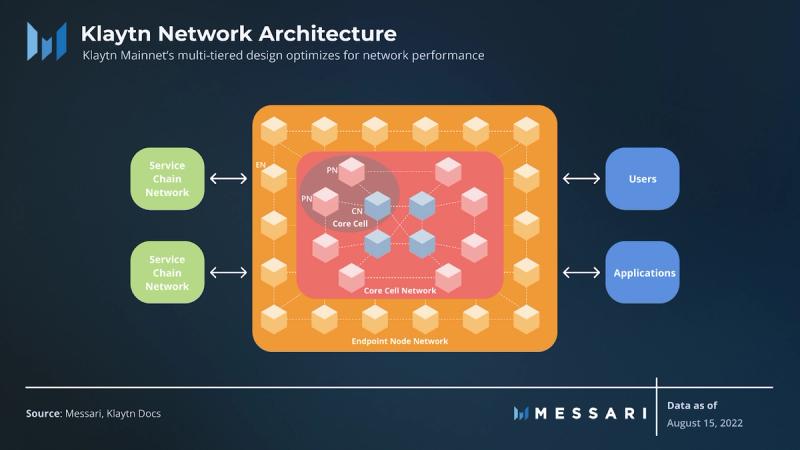
The Klaytn blockchain is composed of three networks: the Core Cell Network (CCN), Endpoint Node Network (ENN), and the Service Chain Network (SCN). The CCN and ENN work together to comprise Klaytn’s Mainnet, while the SCN consists of auxiliary blockchains (i.e., sidechains) independently operated but connected to the mainnet through Endpoint Nodes (EN).
Each Core Cell in the CCN consists of one Consensus Node (CN) and at least two Proxy Nodes (PN). The set of CN operators is a permissioned group known as the Governance Council (GC). They perform consensus, creating blocks with transactions that they verify and execute. PNs serve as a relayer for transaction and block information between CNs and ENs. Core Cells are split into CNs and PNs to shield CNs from adversarial network attacks like DDoS attacks.
ENs connect the CCN with users, applications, and Service Chains. They create transactions, handle RPC API requests, process data requests from Service Chains, and broadcast block information to all Klaytn network participants.
Service Chains allow applications and enterprises to have their own dedicated, customizable execution environment. Service Chains give enterprises a level of decentralization and security that best fit their needs, whether that means higher TPS or private data. Service Chains can connect to Klaytn Mainnet through data anchoring and multi-sig token bridges.
Multi-Channel Propagation
Nodes can set up two ports for communication. If connecting nodes both choose to do so, they can use two channels for communication. One channel is always used for consensus and block-related messages, and the other is used for transaction-related messages.
By using this multi-channel approach, consensus communication is not affected by network congestion at times of high transaction volume, allowing the network to freely create and propagate blocks. The Klaytn Foundation tested the network’s latency over a weeklong period and found an average latency of 2.1 seconds. This is low for a blockchain but still high for Web2 users — most gamers expect latency to be below 100 milliseconds.
Consensus Mechanism
Klaytn is a Proof-of-Stake network that uses an optimized version of Istanbul Byzantine Fault Tolerance (IBFT). IBFT builds on Practical BFT (PBFT), introduced in 1999. In a BFT-based blockchain, a transaction included in a block takes a certain amount of further block confirmations to be considered irreversible, due to the possibility of a fork. To guarantee immediate finality, consensus nodes in PBFT-based blockchains communicate with each other to carry out validation and consensus for each block. Because this communication method increases exponentially with the number of nodes, PBFT is not scalable.
IBFT avoids scalability issues by randomly selecting a fixed number of nodes to perform consensus each round. Each round, one CN is randomly selected to propose the new block, while other CNs are randomly selected to form a committee for the round. Consensus is reached when more than two-thirds of the committee’s members agree on the proposed block. The committee size is currently 30 validators. The probability of being selected is proportional to the amount of KLAY staked. Klaytn’s rounds last approximately 1 second.
The committee allows an IBFT-based blockchain to add new nodes without increasing communication volume. Although nodes publicly broadcast consensus results, there is a possibility for collusion since they communicate for consensus. Thus, IBFT is only an attractive design for enterprise blockchains whose consensus nodes are operated by corporations and other trusted organizations. Ultimately, IBFT sacrifices some decentralization for instant transaction finality, a necessity for enterprise services.
Staking and Hardware Requirements
The Klaytn Governance Council (GC) is the network’s set of consensus nodes. Entities need to stake a minimum of 5 million KLAY and be approved through the Klaytn governance process in order to join the GC. Consensus node operators also need to meet the system’s hardware requirements. A “Gini Coefficient” is in place to distribute power from higher-staking nodes to lower-staking nodes, using the following formula:
Effective staking amount = Actual staking amount ^ (1/1+gini coefficient)
Computation
The Klaytn Virtual Machine (KLVM) was EVM-compatible upon launch, and after a series of updates in Q1’22, it is now EVM equivalent. EVM equivalence is a much stronger version of compatibility. It allows protocols from other EVM environments to launch on Klaytn with virtually no changes in the code.
Accounts
Klaytn’s accounts have several distinctions from Ethereum’s account-based model that enable a better user experience. In typical blockchains, a user’s address is closely tied to the public and private key pair. Klaytn users, however, can have addresses that are decoupled from the key pair.
This setup has several advantages including:
- Users can connect multiple key pairs to their address to increase security.
- Users can change their key pair if it has been compromised (rather than having to generate a new address and key pair and migrate everything over).
- Users can choose the addresses they want.
The last point will have a bigger impact once Klaytn implements human-readable addresses, which is currently under development. The development will allow addresses to be a 20-byte text string mapped to the typical 20-byte address in the backend.
Tokenomics
Klaytn’s native token KLAY is used for transaction fees and for securing the network via validator staking. Ten billion tokens were originally minted at genesis, with no total fixed supply. The token has a target annual inflation rate of around 3%, which can be changed by governance, as prescribed by the GC. A recent protocol update enacted a burn mechanism for half of all transaction fees.
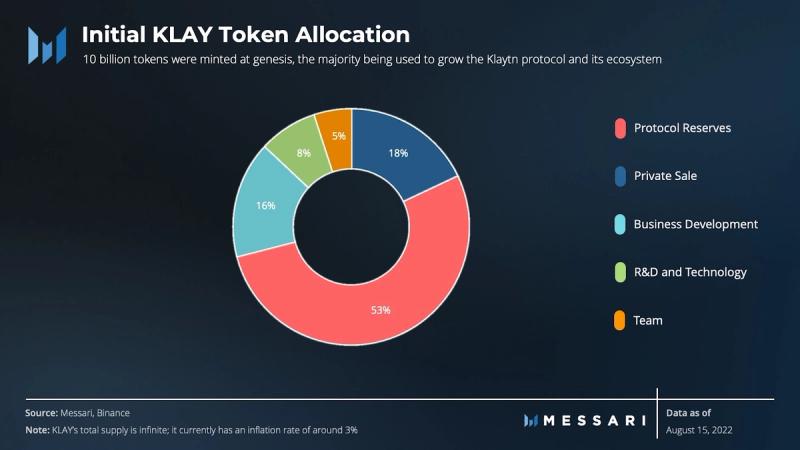
KLAY’s distribution is quite fair, with most tokens being used to further the protocol’s growth. The allocation to the team/protocol company and VCs (23%) is substantially lower than other alt-L1s like Solana (48%), Avalanche (42%), Algorand (39%), Binance Smart Chain (50%), and NEAR (38%).
Protocol Reserves are mostly used for investing in the Klaytn ecosystem. Investment operations are managed by Kakao subsidiary Krust who work alongside the Klaytn Foundation. From Q4’21 to the end of July 2022, Krust made 26 investments, mostly in the DeFi and Gaming sectors.
Un-burned transaction fees don’t only go to validators (the GC), but they also funnel to other network contributors through reserve funds. Each block, half of all transaction fees, and the newly minted 9.6 KLAY per inflation are distributed as follows:
- Klaytn Governance Council (GC): 34%
- The GC is the collective group of entities who operate Core Cells. Each round, one member of the GC is randomly chosen to be the block proposer, and they receive the entirety of the GC reward for that block.
- Klaytn Growth Fund (KGF): 54%
- The KGF serves as an ecosystem fund, providing grants to and investing in projects or individuals that are building on Klaytn. The Klaytn Foundation manages the KGF. It has distributed over 200 million KLAY since launch to 77 projects, 95% of which has come since the beginning of 2022. The Fund currently has around 300 million KLAY (~$70 million at time of writing).
- Klaytn Improvement Reserve (KIR): 12%
- The KIR generally funds R&D for Klaytn, including infrastructure, audits for protocol updates, analytics reports and dashboards, and education initiatives. KIR proposals are voted on by the GC, with each member receiving one vote. Successful proposals still need to meet their stated milestones and deliverables to receive funding. The Reserve has deployed over 10 million KLAY and currently has around 100 million KLAY (~$23 million at time of writing).
Current State of the Klaytn Network and Ecosystem
Network Activity
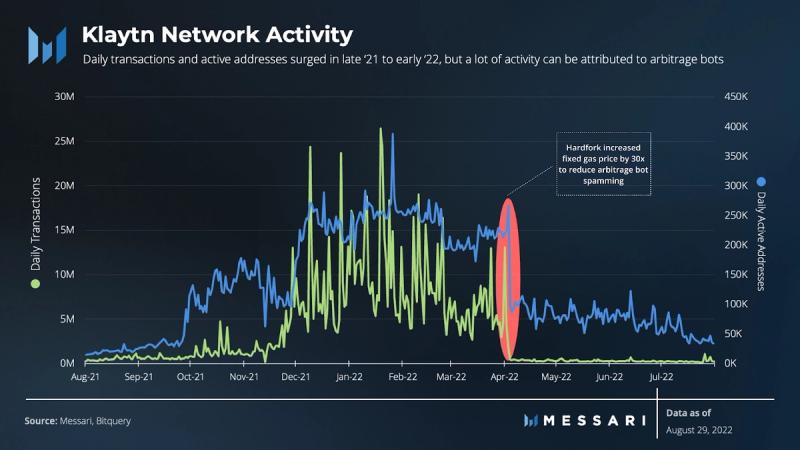
After launch, initial adoption came through integration with KakaoTalk, Kakao’s free mobile instant messaging application that has over 45 million users. Ground X’s wallet Klip allows KakaoTalk users to easily send and receive digital assets on Klaytn. Klip obfuscates complex wallet addresses and seed phrases, providing a more friendly onboarding experience for Web2 users. To date, Klip has over 3 million registered users.
Like many other alt-L1s, Klaytn network activity did not take off until the second half of 2021, when high Ethereum gas fees led users elsewhere. The spike in Klaytn’s daily transactions from the beginning of Q4’21 to the end of Q1’22 is particularly high compared to other blockchains. During this period, Klaytn’s circulating market cap (i.e., network value) also increased to as much as $4.75 billion, ranking it 40th among all cryptocurrencies. However, a significant amount of the transaction volume and value can be attributed to arbitrage bots.
A combination of cheap fixed gas prices and random ordering of transactions in the mempool led to bots spamming the network in hopes of winning arbitrage opportunities, which caused network congestion. As the number of transactions exceeded what nodes could process in normal time, users experienced delayed transaction speed. In Q1’22, Klaytn switched to a time-based ordering mechanism for transactions among other technical solutions, but more needed to be done to combat the issue.
On April 3, a hard fork increased Klaytn’s fixed gas price from 25 to 750 ston ($0.00012 to $0.0035 at the current KLAY price of $0.23). Ston is Klaytn’s gas unit equivalent to Ethereum’s gwei. Although the increase successfully reduced network congestion, it was unpopular within the community, despite burning all excess gas fees above 25 ston. Just as network value increased following the spike in transaction volume in Q4’21, network value sharply declined following the decreased transaction volume in Q2’22. Its market cap is now around $710 million, 71st among all cryptocurrencies.
At the end of August, a network hard fork included a more permanent fix by switching to dynamic gas fees. With an initial range set from 25 to 750 ston, half of all gas fees will be burned.
Ecosystem
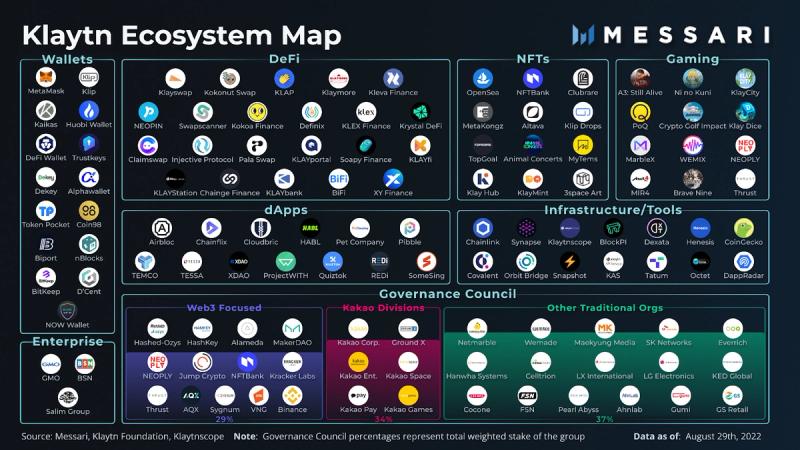
Governance Council
The GC currently consists of 35 participants. Together, they are staking roughly 1.5 billion KLAY, almost half of the token’s circulating supply.
The Gini Coefficient, which is 0.64 at the time of writing, has successfully raised the Klaytn network’s Nakamoto Coefficient from 2 to 4. However, Klaytn’s Nakamoto Coefficient is still on the lower end compared to other blockchains. Additionally, four of the top six validators are Kakao Corporation and three of its subsidiaries, together controlling over 33% of the network.

GC members are seen as strategic partners and often contribute to the ecosystem in other ways besides block production. For example, the second largest GC member is game developer Netmarble, whose blockchain subsidiary MarbleX is building AAA-rated games on a Klaytn Service Chain.
Since inception, the number of Web3-focused GC members has grown from 2 to 13, with additions such as MakerDAO, Alameda Research, NFTBank, and Binance. Although the percentage of GC members focused on Web3 has increased over 6x from 6% to 37%, their combined share of block production has only grown by 3x. The slower growth is due to many Web3-focused GC members staking the minimum 5 million KLAY.
Recently, the Klaytn Foundation announced that two more Web3-focused entities will be joining the GC: DEX aggregator 1inch and blockchain infrastructure builders Krosslab. Additionally, Kakao Space and fintech company Worldpay will be stepping down from the GC. Lastly, Kakao Corp, Kakao Pay, Kakao Entertainment, and Ground X plan to reduce their individual stakes to the minimum 5 million KLAY. They are four of the top six validators, staking a combined 655 million KLAY. They plan to use their excess KLAY for ecosystem growth. Altogether, these changes would increase the Nakamoto Coefficient and distribute network influence from Kakao and its subsidiaries to Web3-focused entities.
DeFi
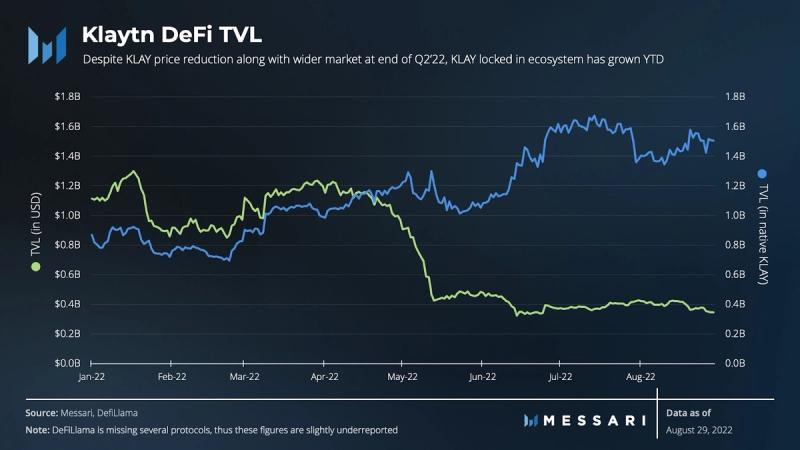
There is currently $317 million total value locked (TVL) in Klaytn DeFi protocols, ranking it 14th among all chains, according to DeFi Llama. Klaytn’s ecosystem faced a significant decrease in TVL calculated in USD starting at the end of April. This drop can be attributed to KLAY price depreciation, resulting from the larger market reduction following macroeconomic headwinds and the Terra collapse.
Despite these adverse conditions, the amount of KLAY locked in DeFi protocols has increased by 73% YTD. This is a mark of ecosystem growth and resiliency in the midst of a crypto bear market.
Over half of Klaytn’s TVL resides in KlaySwap, an automated market-making decentralized exchange (AMM-DEX) developed by OZYS. Klayswap was Klaytn’s first AMM, launching in late 2020. Although it uses the constant product market-making technology popularized by Uniswap, it has several additional features. These include a liquid version of staked KLAY (sKLAY) and a voting escrow counterpart for their governance token.
Klap is Klaytn’s leading overcollateralized lending protocol, with around $18 million TVL not including the $18 million amount of borrows. Klap originated as an Aave fork, but it also blends together many other protocols like Solidly (veNFTs), Platypus (yield boosters), Curve (voting escrow governance), and Geist (penalties for mercenary capital).
NFTs
In Q2’21, OpenSea integrated with Klaytn, making it the first blockchain outside of Ethereum to support the marketplace. The top 10 projects have accumulated a combined 145 million KLAY in volume on OpenSea. At the end of Q2’22, Klaytn partnered with OpenSea to grow the NFT ecosystem in Asia.
Gaming
Facilitating on-chain gaming is one of Klaytn’s main focuses. Including Kakao Games, seven of Klaytn’s GC members are game developers or publishers. Many of them are integrating blockchain elements into existing and new games using Klaytn Mainnet and Service Chains.
Currently, all four of the Klaytn Service Chains are gaming focused. They are operated by:
- MarbleX: blockchain subsidiary of GC member Netmarble, the largest South Korean mobile-gaming company. They added play-to-earn mechanics into recent releases A3: Still Alive and Ni no Kuni: Cross Worlds — both of which have several million downloads on Google Play.
- NEOPLY: GC member and blockchain subsidiary of NEOWIZ, a leading South Korean game publisher. In April 2022, they airdropped $150,000 worth of KLAY alongside their release of mobile sports game Crypto Golf Impact.
- Wemix: blockchain subsidiary of GC member Wemade, South Korean game developer most known for their Legend of Mir series which has been played by over 120 million users. The fourth edition, MIR4, integrates play-to-earn mechanics and has over 5 million downloads on Google Play.
- Bora: subsidiary of Kakao Games that migrated its blockchain from a sidechain connected with Ethereum to a Service Chain in Q4’21. Bora has its own native cryptocurrency and Governance Council. Released games include Birdie Shot, Competz, ArcheWorld, Meta Toy DragonZ, and SuperWalk.
At the end of August, DeFi Kingdoms announced that its Serendale world will migrate from the Harmony blockchain to the Klaytn network. DeFi Kingdoms has been one of the most popular blockchain games over the past year.
Roadmap
Technical Improvements
In Q1’22, the Klaytn Foundation announced a revamped Klaytn 2.0 litepaper. The new roadmap features many improvements, but they all center around the goal of building a blockchain suited for the metaverse and mass adoption. The three main areas of focus are on improving scalability, decentralization, and infrastructure.
The Foundation plans to improve scalability by optimizing its base-layer protocol and increasing support for Service Chains. Through consensus mechanism improvements, the team hopes to increase network TPS from 4,000 to 10,000 by the end of the year. The Foundation aims to add more Service Chains, which will reduce mainnet congestion. In order to entice more service providers to build a Service Chain, the team plans to allow for more seamless bridging between mainnet and Service Chains. Lastly, nested Service Chains, which are Service Chains that act as hubs for other Service Chains, will allow for exponential scalability.
On decentralization fronts, the Klaytn Foundation aims to increase total GC members while also increasing the presence of DAOs to 30%. Currently, the Klaytn network can support a maximum of 50 GC members. While the Foundation is working on onboarding new members to reach that maximum, it will also work to optimize the consensus mechanism to sustain 100 GC members. Once the Gini Coefficient is no longer needed to sufficiently decentralize the GC, it will be discontinued.
The Foundation also plans on adding more transparency to the governance process as a whole. They are working on transferring governance to an on-chain portal by the end of the year. At the moment, the governance process is all off-chain, using Web2 tools like Slack and Google Forms.
Ethereum equivalence was a key first step in creating a more friendly developer environment. Beyond this, the Klaytn Foundation plans to build a metaverse package for developers, including tool sets, SDKs, and smart contract libraries.
Growth Strategy
As an enterprise-grade blockchain, Klaytn’s path to success is forming strong partnerships with both Web2 and Web3 entities to become active members of its ecosystem. Upon launch, many of Klaytn’s partners participated in the network solely as Governance Council members. Since then, the Klaytn Foundation has focused on onboarding GC members who will add value in additional ways, such as launching their multichain protocol on Klaytn Mainnet or creating a Service Chain.
The Klaytn team has also formed several key partnerships outside of the Governance Council. In July 2021, Ground X won the bid for Bank of Korea’s CBDC project, which will be implemented on a private Service Chain. Ground X also partnered with ConsenSys, a leading blockchain technology company, to design and implement the architecture. The project is still in its proof of concept stage.
In Q1’22, the Klaytn Foundation announced that it will be building a blockchain on China’s Blockchain-based Service Network (BSN). The BSN is a collection of blockchain frameworks that China aims to make the standard for all blockchain deployments in the country. Klaytn’s Chongqing Chain will allow Klaytn developers to tap into the Chinese blockchain network and for Chinese developers to reach a global user base.
Beyond partnerships, the Klaytn Foundation seeks to grow the network’s ecosystem by deploying the Growth Fund for project grants and investments. Because a significant portion of transaction fees go to the Fund, the mechanic has a flywheel effect where ecosystem funding attracts more network activity and transaction fees, which generates more funds. Kakao Corp and three of its subsidiaries plan to reduce their stake to the minimum 5 million KLAY. This action will free up 635 million KLAY that is currently staked for ecosystem growth.
Summary
With its IBFT-based consensus mechanism, multi-channel propagation, and multi-tiered network including customizable Service Chains, the Klaytn network is primarily designed for enterprise use. However, the Foundation has also targeted retail participants, mainly via on-chain games. Since launch, the Klaytn ecosystem has experienced steady growth with a strong presence in South Korea and Southeast Asia. The Klaytn Governance Council now has 35 members, a growing percentage of which are integrating or building their service on Klaytn Mainnet or a Service Chain. The amount of KLAY locked in Klaytn Mainnet’s DeFi protocols has grown 73% since the beginning of the year, despite adverse market conditions. Several of South Korea’s largest gaming companies are using Service Chains to integrate play-to-earn mechanics into their popular games.
The growth came with some setbacks, as the increased network activity from the end of 2021 to early 2022 caused network congestion. Nevertheless, the team will continue to build on its technical solutions to provide a scalable and reliable network.
Beyond technical improvements to the protocol, the Klaytn Foundation aims to further grow the ecosystem by cultivating partnerships and deploying the Klaytn Growth Fund. If the Klaytn Foundation is successful, the Klaytn blockchain will maintain its place as one of the industry’s leading enterprise blockchains.



















